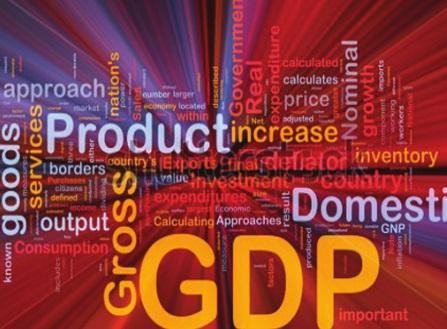On July 21, the National Bureau of Statistics (NBS) unveiled the much-anticipated rebased GDP figures, updating the base year for real GDP calculations from 2010 to 2019. The rebasing exercise introduced several key revisions, including (1) a marked increase in nominal GDP, prompting a recalibration of major economic ratios, (2) a shift in the economy’s sectoral composition and (3) adjustments to real GDP growth rates relative to the old base year.
Based on the revised series, real GDP expanded at a slower pace in Q1-25, rising by 3.13% y/y (Q4-24: +3.76% y/y), largely due to a broad-based deceleration across both oil and non-oil segments. In light of these structural adjustments and actual Q1 data, we have revised our 2025 full-year GDP growth forecast downward to 3.60% y/y, from an earlier estimate of 3.90% y/y.
Better Sector Coverage Raises Nominal GDP Figures
Nominal GDP figures rose significantly following the rebasing exercise, largely reflecting the inclusion of newly captured economic activities, particularly within the services and industry sectors, as well as broader coverage of the informal economy.
According to the National Bureau of Statistics (NBS), the updated GDP computation now accounts for areas such as digital economic activities, pension fund administration, the National Health Insurance Scheme (NHIS), the Nigerian Social Insurance Trust Fund (NSITF), modular refineries, domestic households as employers of labour, and quarrying and other mining activities. As a result, nominal GDP figures for all years between 2019 and 2024 were revised upward, with the 2024 estimate rising by 34.4% to NGN372.82 trillion.
Change in the Economy’s Composition and Adjustment in Growth Rates
The post-rebasing results also revealed a shift in the economy’s structure, marked by a notable increase in the agriculture sector’s share, a modest adjustment in the services sector, and a decline in the industry sector’s contribution to GDP.
The rise in agriculture’s share of GDP reflects improved coverage of livestock, fishing, and forestry, which offset the decline in the share of crop production. Within the services sector, the contributions of ICT, finance, insurance, and transportation to real GDP declined, while trade and real estate increased, mainly due to improved coverage of the informal sector.
Within the industry sector, contributions from oil and manufacturing declined, while the share of the construction sector increased. Additionally, growth rates for various sectors were adjusted following the shift from the previous GDP base year.
Notably, finance and insurance growth was revised sharply downward to an average of 2.6% between 2020 – 2024 (from +18.4%), reflecting the reallocation of Financial Intermediation Services Indirectly Measured (FISIM) in line with the 2008 System of National Accounts (SNA), which excludes portions used by businesses and government from GDP.
Increased Nominal GDP Leads to a Drop in Key Economic Ratios
Given the upward adjustment in nominal GDP, we highlight the decline in key economic and financial ratios.
This reflects technical improvements in measurement, providing a more accurate picture of the economy and supporting well-guided monetary & fiscal policy, as well as informed domestic and foreign investment decisions.
A sustained improvement in these key ratios is likely to further improve Nigeria’s credit rating and bolster investor confidence.
Nigeria Remains the Fourth Largest Economy
Although Nigeria’s nominal GDP in US dollar terms rose (+34.4% to USD250.86 billion), the increase was insufficient to surpass the continent’s top three economies, including South Africa, Egypt, and Algeria, thus retaining Nigeria’s position as the fourth-largest economy in Africa.
The uplift in the rebased GDP was not substantial enough to offset the significant erosion in dollar value resulting from persistent currency depreciation, particularly when compared to the relative currency stability in the top three economies.
Based on our estimates, Nigeria’s nominal GDP would need to grow at an average annual rate of 20.0% over the next four years (starting from 2024) to reclaim its position as Africa’s largest economy, assuming a stable exchange rate of NGN1,530.00/USD and using IMF GDP projections for the leading economies.
GDP Grew by 3.13% y/y in Q1-25
Q1-25 GDP growth numbers were also released, indicating that the economy grew by 3.13% y/y in Q1-25 (Q4-24: +3.76% y/y | Q1-24: +2.27% y/y), a slowdown from the previous quarter, reflecting softer economic activity due to seasonal factors.
However, we note the significant improvement year-on-year, driven by the easing of strains induced by the reforms, naira stability, and increased business confidence. Based on the data, both the oil (+1.87% y/y vs Q4-24: +5.47% y/y | +4.71% y/y) and non-oil (+3.19% y/y vs Q4-24: +3.80% y/y | Q1-24: +2.17% y/y) sectors slowed from the prior quarter, though the non-oil sector recorded stronger growth compared to Q1-24.
Oil Sector Growth Remained Positive
The oil sector grew at a slower rate in Q1-25, rising by 1.87% y/y, compared to 5.54% y/y in Q4-24. We believe the slower growth reflects a high base from the same quarter of the prior year, as well as structural adjustments associated with the rebasing exercise. According to the NBS, crude oil production averaged 1.62 mb/d, a 3.18% increase from 1.57 mb/d recorded in Q1-24. The sustained positive growth in the sector reflects the combined effects of (1) enhanced oil infrastructure security, (2) improved sector investments, and (3) reduced operational disruptions. Despite a slower growth, the oil sector’s contribution to GDP increased to 3.97% in Q1-25 (Q4-24: 2.80% | Q1-24: 4.15%).
Non-oil Sector Growth Tempers but Remains Robust
Growth in the non-oil sector slowed to 3.19% y/y (Q4-24: +3.80% y/y) but outpaced Q1-24 growth numbers (+2.17% y/y). GDP growth moderated across the agricultural and service sectors, while the manufacturing sector continued to expand. The non-oil sector’s contribution to GDP moderated to 96.03% from 97.20% in Q4-24.
Services: The services sector grew at a moderate pace of 4.33% y/y in Q1-25 (Q1-24: +4.06% y/y | Q4-24: +4.75% y/y), reflecting a slower expansion in trade (+1.78% y/y vs Q4-24: +2.04% y/y) and real estate (+4.61% y/y vs Q4-24: +5.28% y/y) activities. We attribute the ease in the trade sector growth to reduced consumer spending following the conclusion of festive activities in Q4-24. Meanwhile, real estate growth remained modest, constrained by high borrowing costs that continued to dampen housing finance and property development. In contrast, the finance and insurance, ICT, and transportation subsectors recorded stronger growth.
Finance and insurance expanded significantly by 15.03% y/y (Q4-24: +5.99% y/y), likely supported by higher net interest income amid elevated interest rates and increased growth in mutual and pension funds. ICT grew by 7.40% y/y (Q4-24: +7.00% y/y), aided by improved growth in demand for telco services and increased investment in the sector given the ease in currency pressures and the Nigerian Communications Commission’s (NCC) directive for a 50.0% increase in telecom tariffs. Transportation activity rose by 14.08% y/y (Q4-24: +13.21% y/y), driven by infrastructure improvements and better petroleum supply.
Agriculture: The agriculture sector recorded a sharp deceleration in Q1-25, growing marginally by 0.07% y/y (Q4-24: +2.54% y/y), driven by a steep contraction in livestock production and slower forestry growth, despite an improvement in crop production. Specifically, livestock output (-16.69% y/y vs Q4-24: +1.39% y/y) declined significantly, reflecting the impact of insecurity and rising input costs. Forestry growth also moderated to 1.82% y/y (Q4-24: +8.38% y/y). In contrast, crop production (+3.71% y/y vs Q4-24: +2.75% y/y) remained strong, supported by an extended harvest season in Q1-25, while the fishing sub-sector (-0.21% y/y vs Q4-24: -0.53% y/y) declined at a softer pace.
Manufacturing: Manufacturing output expanded by 1.69% y/y in Q1-25 (Q4-24: +1.28% y/y), supported by reduced naira volatility and easing of inflationary pressures. Growth was driven by a recovery in key sub-sectors, including oil refining (+11.51% y/y vs Q4-24: +9.36% y/y), reflecting improved operational capacity at local refineries. The motor vehicles & assembly segment posted stronger growth at 4.25% y/y (Q4-24: +2.78% y/y), while electrical & electronics manufacturing rose by 1.14% y/y (Q4-24: +0.83% y/y). Food, beverage, and tobacco also maintained a positive trajectory, growing by 3.48% y/y (Q4-24: +2.32% y/y), bolstered by robust consumer demand and improved raw material availability.
Outlook – GDP Projected to Grow by 3.60% in 2025FY
Oil GDP: We maintain our optimism around the oil sector. We expect the improved investment and sustained security measures in the oil sector to yield higher output in H2-25. Specifically, we expect crude oil production to average 1.72 mb/d in H2-25, leading to an average of 1.70 mb/d in 2025, based on data from the NUPRC. Nonetheless, due to structural changes in the rebased GDP data, we have adjusted our growth estimates for the oil sector. We now forecast the oil sector to grow by an average of 6.40% y/y in 2025FY (previous: 8.21% y/y; 2024FY: 5.63% y/y).
Non-Oil GDP: The non-oil economy is expected to maintain resilient growth, supported by a gradual recovery in household consumption as inflation moderates, alongside improved business investment driven by relative naira stability and easing input cost pressures. However, persistently high borrowing costs stemming from tight monetary conditions will continue to constrain growth below its potential trajectory. Given the overall adjustments in the GDP growth numbers under the rebased framework, we have revised our non-oil GDP growth forecast downward to 3.50% y/y for 2025FY (Previous: +3.64% y/y), higher than the revised 2024FY growth of 3.26%.
Services: We expect the services sector to maintain robust growth, supported by stronger expansion in trade, ICT, transportation, and finance and insurance subsectors. However, a moderate pace of growth in the real estate sub-sector, driven by high financing costs and structural barriers, such as land acquisition, may soften overall sectoral performance compared to the previous year. In trade, improved consumer spending and naira stability should sustain growth. For ICT, sustained growth in demand for telco services and increased investment in infrastructure are expected to drive expansion. Meanwhile, in the finance and insurance sectors, high net interest income and strong yields in mutual and pension funds are likely to remain key growth drivers. Reflecting downward revisions under the rebased GDP figures, we now project the services sector to grow by 4.30% y/y in 2025 (2024FY: +4.40% y/y), down from our earlier forecast of 4.66% y/y.
Agriculture: We expect the harvest periods (green and main harvest) to drive stronger crop production subsector growth in H2-25. Additionally, we anticipate a gradual recovery in livestock activities as input cost pressures support a mild expansion in production, although existing structural constraints, including insecurity, poor infrastructure, and underinvestment, will continue to be a downside to robust growth. Given the upward revision to growth in the agricultural sector for 2024FY (+1.43% y/y vs 2010 base year: +1.12% y/y), we raise our 2025FY agricultural sector GDP growth to 2.02% y/y (previous: +1.87% y/y).
Manufacturing: The manufacturing sector is expected to benefit from improved FX liquidity, reduced exchange rate volatility. Additionally, we expect rising local refining activities will continue to support gradual expansion in the manufacturing sector. While the high cost of financing and structural inefficiencies continue to pose downside risks. We also revise our GDP growth estimate for the manufacturing sector downward to reflect adjustments in the rebased GDP figures (2024FY: +1.20% y/y vs 2010 base year: +1.37% y/y). We now expect the manufacturing GDP to grow by 1.52% y/y (Previous: +2.05% y/y).
Overall, we revise our real GDP growth estimate downward to 3.60% y/y in 2025FY (Previous: +3.90% y/y), up from 3.34% in 2024FY
Cordros





















